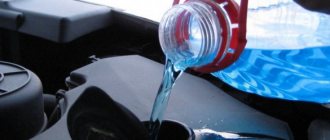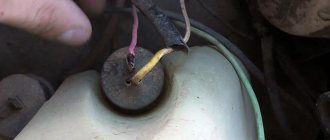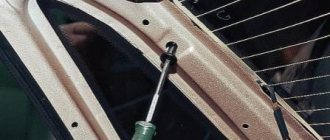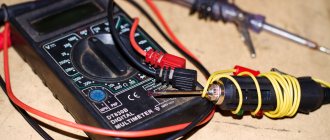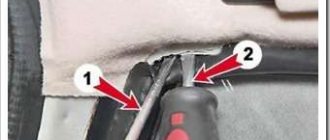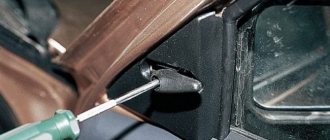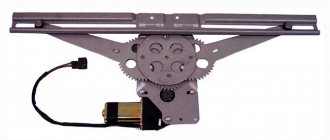Today, a car is unthinkable without a windshield washer; we are too accustomed to the fact that, at our first request, washer fluid splashes from the nozzles, and after it, the wipers wash away road dust and the pitiful remains of insects hitting the windshield. But what to do if suddenly the VAZ 2110 washer motor refuses to perform its functions? If the pump does not work, then you have to forget about the cleanliness of the glass, or wash it the old fashioned way, by hand with water and a rag.
Washer device
Is the windshield washer on your VAZ-2110 broken? No problem!
The windshield washer is a rather useful and necessary invention in the VAZ-2110 car.
This device was created to make life easier for drivers. When there are no problems with the windshield washer on a VAZ-2110 car, we simply do not notice it and perceive it as an ordinary thing. But when there is a problem with it, we immediately remember its pricelessness and irreplaceability. It may seem to some that it is simply impossible to drive a VAZ-2110 without a windshield washer. This is true. We quickly get used to good things. The same situation applies to the washer. After all, once upon a time this function was not available in cars, and this suited any driver. At that time it seemed to them that the car had everything they needed and there was nothing more to add.
In this material we will talk specifically about the windshield washer in VAZ-2110 cars. We will look at the possible reasons for its malfunction and learn how to deal with these problems.
At its core, a windshield washer consists of two parts - mechanical and electrical. Malfunctions in this device in VAZ-2110 cars often appear in the mechanical part, but in most cases such problems are insignificant and do not require any effort to eliminate them.
One day, one fine morning, you get into your car and want to wash the windshield. You press the washer button and... Commenting obscenely on what is happening, you get out of the car, take the first rag that comes to hand and go to wipe the glass.
Mechanical reasons why the windshield washer may not work
- The most common reason that drivers do not pay attention to is the lack of fluid in the washer reservoir of the VAZ-2110. We think there is no need to describe the solution to this problem. If the car owner is absolutely sure that there is liquid in the container, and the temperature outside is below 0 degrees Celsius, there is a possibility that it is simply frozen. Some people, instead of special liquid, pour ordinary water into the washer reservoir, and then are surprised that at sub-zero temperatures it turns into ice. This problem is solved by warming the engine up to operating temperature. You can simply leave the VAZ-2110 in a warm garage overnight. After some time, the frozen water in the tank will melt and the windshield washer will start working again. To prevent the problem from recurring, you should replace the regular water in the container with the liquid provided for this.
- Another common reason is that the hose has fallen off. Quite often, the tube through which the liquid is supplied flies off the nozzles or from the tank itself, and the entire contents simply pour out onto the ground. There have also been cases where the hose became pinched under the hood. In such cases, carefully check the fluid supply hoses along the entire length from the washer reservoir to the nozzles on the hood.
- Clogged washer nozzles. Clogged injectors are a fairly common malfunction in the VAZ-2110. This can happen due to poor quality sprayer fluid. It happens that the injectors become clogged not only with sediment from the contents of the tank, but also with dirt from the windshield. To find out, you need to disconnect the hose from the nozzle and check the fluid supply. If water appears at the end of the tube, the injectors are clogged. They can be cleaned or replaced with new ones.
Main problems
All existing faults with the front washer can be divided into two main types, which have their own sub-problems, so to speak. We invite you to familiarize yourself with them in the table.
Fault type
Failure options
The washer fluid reservoir is empty
The hose fell off the pump
But each of these faults deserves a more detailed consideration.
Mechanical breakdowns
It is with mechanical washer malfunctions that owners of the VAZ 2110 most often encounter. This is compared with the regularity of electrical problems.
- The washer fluid tank is empty. Inexperienced drivers often start blaming a faulty pump, although in practice they simply forget to check the antifreeze level in the tank. Hence the unjustified costs for the services of service stations. Don’t forget to check the fluid level, and in winter, be sure to drain the regular washer fluid and fill it with anti-freeze in its place. Ordinary water at subzero temperatures will turn into ice, and therefore will not be able to take part in cleaning the windshield. If you still forget to drain and the water freezes, warm up the car for a while so that the ice melts, then drain and fill with a suitable liquid.
- The hose fell off. Anti-freeze is supplied from the tank to the windshield using a pump and special hoses. If these same hoses begin to jump out of their places, the liquid will not be able to flow to the nozzles. As a result, the washer does not function. Try to secure them better. And if they are worn out, simply replace the old hoses with new ones. If the mounting is normal, water may still not flow to the nozzles. In this case, check whether the hoses are pinched.
- The injectors are clogged. The anti-freeze agent, supplied by a pump and passing through hoses, then exits onto the windshield using nozzles. These are the same small devices from which streams of water come. If they are dirty, disconnect the hoses from the injectors and check their condition. Often the problem lies in the jets. They are easy to clean, but in some situations they may need to be replaced.
Windshield washer mechanics: nozzles do not spray
So, the mechanical reasons why the windshield washer does not work:
— The washer fluid froze. It seems stupid, but quite often using ordinary water, and with the onset of the first frosts, antifreeze, many drivers forget to remove the water from the washer hoses and pump in antifreeze fluid instead. The water in the pipes turns to ice and the windshield washer does not work
, since the liquid cannot overcome the ice plug. The way out of the situation is to warm up the engine, close the hood and put the car in a room with above-zero temperatures. After a while, the windshield washer will start working.
— the hose jumped off. This is also a fairly common reason. The liquid from the tank does not go to the fittings, but flows somewhere before reaching them.
— the engine shaft turned. Under heavy loads (usually when the liquid in the tank freezes), the motor shaft can rotate inside the part placed on it. This is a fairly common reason on VAZ cars. At the same time, you can hear that the washer motor is humming, but no liquid is pouring onto the glass. In this case, only replacing the entire mechanism will help.
— the hose going to the washer nozzles is pinched. It occurs on cars where the fittings are located on the hood; when it is closed, the hoses become strongly bent and stop passing liquid through them.
The washer nozzles (fittings) become clogged with water deposits.
— the fittings (washer nozzles) are clogged with dirt, ice or water deposits. Remove the hose from the fittings; if liquid comes out, then the problem is in them. They need to be replaced with new ones, especially since they are inexpensive.
It will be useful: Additional pump VAZ-2115: how to install and connect
Removing and disassembling the windshield wiper
We optimize injectors
If the engine starts running , the fluid is pumped up and the nozzles spray it efficiently onto the windshield, then the work can be considered completed successfully. If the system works, but the nozzles do not cope with their task, then they need to be replaced.
But there are options here. You can install a standard version of the nozzle or optimize the system a little - install double or fan jets. If desired, you can install injectors from a foreign car. The main thing here is that they fit neatly into the connector.
To increase the coverage area of the washer, you can install an additional nozzle, move the nozzles to the hood, or mount fan nozzles instead of standard nozzles (we have already talked about this).
In addition, to improve the performance of the washer, the factory pipes are often replaced with better ones (in this case, the problem of freezing the liquid in winter is solved). In particular, special aquarium tubes can be used for such work.
Monitor the windshield washer system and troubleshoot problems in a timely manner (change and clean nozzles, replace the pump and tubes, restore wiring). Otherwise, bad weather can turn your trip into hard labor.
READ VAZ 2109 heater fan does not work
Electrical glass washer: common problems
Let's look at the electrical reasons why the washer does not work:
— the fuse has blown. We need to get to the fuse box, use reference books or symbols on the cover to find the one we need, check it, and if it is blown, replace it with a new one.
— the terminals attached to the motor terminals have oxidized or decomposed and fallen off. It is necessary to clean the terminals, check the quality of the connections, and put everything back in place. In my opinion, it is best to clean the terminals with a hot soapy solution and a toothbrush.
Why the washer does not work: the fuse is melted or the terminal is faulty
— the washer does not work due to the fact that the washer switch on the steering wheel has failed . If your car automatically turns on the brushes when you press the washer switch and this function works, but the liquid does not splash, then the reason needs to be looked for elsewhere. For those who do not have such a pleasant feature, you should take a multimeter, connect it to the terminals on the washer motor terminals and measure the voltage with the switch pressed. If there is voltage, but the motor does not spin, the latter needs to be replaced. If there is no voltage, then one of three things remains: either the switch does not work, or the washer activation relay does not close, or the electrical wiring is faulty. If replacing the relay did not help, then it is best to contact an auto electrician, or if you yourself understand car wiring, then fixing it will not be so difficult.
Why doesn't the windshield washer work?
The system for cleaning glass and car headlights includes: a liquid reservoir, a pump, nozzles, tubes, electrical wiring and a power button. Most often, the reason why the windshield washer does not work is a faulty motor or a blown fuse. The operating principle of a windshield washer is quite archaic, so simple diagnostics and simple repairs can be performed almost at the doorstep of the nearest auto parts store.
Malfunctions and operating principles of hand and foot-operated windshield washers, which were installed on some VAZ and AZLK models, deserve a separate topic and will not be discussed in this article.
Causes of failure
- The windshield washer pump fuse has blown. Manufacturers mark consumers who are protected by fuse links with graphic symbols on the inside of the relay and fuse box cover. If the markings are unclear or the required insert is not marked, a detailed fuse location diagram can be found in the repair and operating manual for your car. Attention! Installing a larger fuse may cause the vehicle to catch fire. If the new fuse-link burns out immediately after installation, there is a short circuit in the circuit.
- The windshield washer motor is burnt out or soured. The low cost of the pump makes its disassembly and repair impractical, so simply replace it with a new one.
- The contacts on the connectors have oxidized, the power wires have become frayed or broken. In field conditions, oxides can be removed from the terminals with a sharp object. At the same time, do not damage or bend the terminals so as not to disrupt the quality of contact in the connector.
- The coarse filter in front of the windshield washer pump is clogged (not installed on all cars). The filter is attached to an O-ring that seals the pump installation location. If trouble catches you on the road and you cannot clean the filter element, temporarily remove it from the line.
- The hose from the pump to the injectors has fallen off or broken.
- The injectors are clogged. In winter, injectors can become clogged not only with debris and plaque, but also with ice. After using the windshield wiper, a washer fluid remains on the nozzles, from which the alcohol evaporates over time. The water remaining near the nozzle freezes, which is why the windshield washer does not work. You can pierce the injectors with a thin needle.
- The fluid in the washer reservoir has frozen.
Operating principle and connection diagram
The pump consists of a centrifugal wheel that is rotated by a DC electric motor. The liquid captured by the wheel is supplied through tubes to the nozzles. Below is the simplest diagram for switching on the glass washer for VAZ 2104, 2105, 2107 cars.
When the driver activates the windshield washer, the contacts inside the switch close, the gray-black wire connects to the vehicle ground - current begins to flow in the windshield washer circuit.
On VAZ 2110, 2111, 2112, relay K2 is responsible for turning on the windshield washer. It is through this that + is supplied to the pump connector. The second terminal of the electric motor is connected to the car body. A method of constructing a circuit close to this is used on most modern cars.
Where to start diagnostics?
If your car's windshield washer does not work, pay attention to the characteristic symptoms. The electric motor hums when turned on, but liquid does not splash from the nozzles onto the windows. To check, just turn off the engine, turn on the ignition and switch the steering column switch to the windshield washer position. Most likely, the reason is clogged nozzles, a filter element, a flown off, kinked or burst hose.
The windshield washer motor is silent when turned on. There is a problem with the pump, wires or steering column switch. If the fuse is good, proceed to diagnosing the power supply circuit.
The windshield or headlight washer pump requires + and – to operate. Depending on the connection diagram, when you move the steering column lever, one of the wires is shorted to ground or acts as a power wire (a + appears on it). Accordingly, the second wire is either constant + after turning on the ignition, or shorted to ground. The search for an open circuit or short circuit should begin with studying the electrical circuit.
Power check
In order to understand whether the pump is faulty or there is a power problem, it is enough to check the electrical circuits. If you don’t have one with you, use any 12V light bulb and two pieces of wire. Connect one control terminal to the car body, and the second to the positive terminal of the pump connector. If the light comes on after turning on the ignition, unhook the control terminal from the body and connect it to the + battery. Connect the second end of the control to the terminal, which should be shorted to ground when the windshield washer is turned on. If the light comes on, there is no problem with the power supply and the reason is in the motor. A method for checking the windshield washer power supply on VAZ 2104, 2105, 2107 is described, but the approach to finding power at the pump connector is relevant for all cars. To quickly check the windshield washer motor, two wires are enough. Forcefully supply power from the battery to the motor terminals. If the motor does not hum, it must be replaced.
It will be useful: What to do if the brake lights on a VAZ 2110 do not light up and repairs
When you turn on the windshield washer, the wipers make several sweeps in automatic mode. If this does not happen, start by checking the steering column switch, relay and wires from the switch to the pump. To do this, arm yourself with the same tester or multimeter. A tester in resistance measurement mode is also necessary to check the integrity of the wires. To test, connect the multimeter probes to the ends of the wire. The inscription OL (Over Limit) indicates a break or break in the wire.
Why is the nozzle not spraying?
The washer pump fuse has blown. You can find out the location of the fuse link that protects the electric motor circuit from the repair and operation manual. Very often, on the plug covering the mounting fuse block, the manufacturer, using graphic symbols, indicates the number of the fuse link and the consumer whose circuit it breaks in the event of a short circuit. If you have to change the fuse frequently to operate the washer, there is a short circuit in the circuit.
Instead of a burnt-out insert, install only a fuse of the appropriate rating. Installing fuses designed for high current can result in a vehicle fire.
- The pump has failed. A breakdown can be caused by blocking the rotation of the impeller wheel with dirt or corrosion. The power of the electric motor is not enough to rotate the armature shaft of the electric motor. In some types of construction, corrosion and dirt block the rotation of the motor armature.
- The washer nozzle sprays poorly or does not spray at all, as the nozzle channel is clogged. The cause of the malfunction is corrosion of the channels inside the nozzle and debris entering the tank.
- Motor circuit malfunction. Failure of the steering column switch, an open circuit due to damaged wires, or the formation of oxides on the terminals are the most likely reasons why the windshield washer does not work.
- The hose has torn, broken, or jumped off the pump fitting. Carefully inspect the transition of the hose from the engine compartment to the hood, the secure fit of the hoses to the fittings of the injectors and washer pump.
- The washer fluid in the reservoir has frozen.
Principle of operation
The windshield and rear window cleaning system is based on an electrically driven pump. The armature shaft of the motor is connected to a paddle wheel, which, when rotated, supplies washer fluid through hoses to the windshield washer nozzles. The sealing collar prevents washer fluid from entering the electric motor. It is the leakage that becomes the main reason why the windshield washer pump does not work. Water and glass washer fluid getting inside start the corrosion process, deteriorating the quality of the contacts and increasing the resistance to rotation of the pump armature.
A DC motor is used as a motor. There are at least 2 types of design:
- the pump body is also the body of the electric motor, so permanent magnets are attached to it;
- A separate motor is used, which is assembled and installed in the windshield washer housing.
In most systems, separate pumps are installed for different circuits. But in some cars, one electric motor can wash both the rear window and the windshield. In this case, the direction of fluid supply depends on the polarity of the voltage supplied to the electric motor. For variable supply of liquid in different directions, a check valve is used in the design.
Finding the cause of the breakdown
To determine the breakdown due to which the glass washer has stopped working, use the method of elimination.
- Turn on the windshield washer (there is no need to start the engine, just turn on the ignition). Listen for a buzzing sound coming from where the tank is installed, indicating that the electric motor is turning on. If the motor hums, look for the cause of the failure in the hoses and injectors.
- The electric motor does not turn on. Disconnect the pump connector. If there is enough space around the reservoir, the pump can be checked without removal. To check why the motor is not working, it is enough to directly supply power to its contacts from the battery. To do this, you will need two pieces of wire, one end of which is attached to the positive and negative terminals of the battery. Using the mating parts of the wires, briefly touch the terminals of the windshield washer motor. If there is no immediate reaction, apply voltage in a mirror manner (you can avoid this error if you first study the circuit diagram for turning on the pump on your car). If the motor works, the washer does not work due to problems in the control circuit. Otherwise, the reason is in the pump itself.
Circuit Diagnostics
The voltage is checked by a control. To test the circuit for a break, you will need knowledge of the rules for using a multimeter and the universal meter itself.
- Turn on the ignition.
- Attach one control pin to the part in contact with the unpainted part of the body.
- Ask an assistant to turn on the washer or lock the steering column switch in the appropriate position.
- With the second control contact, touch the pin of the pump power connector, which should have +12 V when the glass washer is running. The ground is checked in a similar way, only you need to move the control contact from the metal part to the positive terminal of the battery.
If the motor is working properly, but the washer does not work, then you will definitely find a lack of power or ground. Next, you need to study the electrical circuit and identify all the elements that affect the operation of the windshield and rear window washer. Use a multimeter in resistance mode to check the wiring. Start diagnostics from the sections of the circuit that are most accessible for diagnostics. When disconnecting the connectors, pay attention to the presence of oxides that negatively affect the operation of the windshield and rear window washer.
It will be useful: Replacing the steering rack of a VAZ 2109 with your own hands: video instructions
Pump repair or replacement?
The feasibility of repair is determined by the cost of a new pump. A large number of pumps are non-separable, so for repairs you will have to cut them and then glue the plastic case together. To repair it yourself, it is enough to completely disassemble the motor, clean its insides from dirt, corrosion and growths.
Of course, you won’t find spare parts for the washer pump, so the sealing lip will remain old. If it was this that caused the jamming, then within a year the windshield washer will most likely not work again.
How to remove and wash injectors
The windshield washer nozzles are held in place by plastic clips. To remove the injector without damaging the body, check its number in the original spare parts catalog. By finding a photo of the injector by number, you will see exactly where the latches are located. You can remove the nozzle with a thin slotted screwdriver.
For cleaning, you can use a needle smaller than the diameter of the sprayer hole. We recommend that you first leave clogged injectors in a citric acid solution for some time. After soaking, the deposit can be removed using carburetor cleaner or compressed air.
Why doesn't the windshield washer work? TOP 8 popular reasons!
Greetings to everyone on the VAZ Repair website. Today we’ll talk about windshield washer. Let's figure out why the glass washer does not work, for what reasons it fails, and also how to prevent its breakdown in the future.
The windshield washer, in my opinion, needs no introduction. Every motorist knows what it is and what it is intended for. The benefits of this simple and at the same time effective device can hardly be overestimated; in the summer it allows you to quickly and easily refresh your “forehead” from dust and insects. With the arrival of cold weather, two presses of the button are enough to remove dirt from the windshield, and in winter the washer allows you to quickly melt the ice and clear the windshield of ice crust.
The washer works in tandem with the wipers, which also depend on this device to clean the glass. Working “dry”, wiper blades are ineffective; moreover, they wear out quickly and often damage the windshield itself.
Considering all of the above, we can draw the logical conclusion that a lot depends on the proper operation of the washer, so at the first sign of its malfunction, urgent measures should be taken.
Video of repairing a washer motor with your own hands
I didn't remove the wheel, I just jacked it up. I unscrewed the two nuts of the coolant reservoir and moved it to the side to get the locker clip pin.
I unscrewed the mudguard and took it off. He took out two clips and bent the protection. I unscrewed the screw at the bottom of the washer reservoir, unscrewed the neck and pulled the reservoir out of the grooves.
I placed the container, pulled the hose out of the pump and drained the antifreeze.
I pry it open with a screwdriver and pull out the pump.
I checked, the motor hums, but does not pump. I started to look into it and it turned out that the hose was pinched when I was screwing on the neck. I adjusted the hose, checked it sprays powerfully, even waters the roof. I put everything back together. I'm thinking of installing fan injectors now.
Nowadays it is impossible to imagine a car without a windshield washer. After all, every driver is accustomed to the fact that dusty glass can be easily cleaned with the help of washer fluid sprayed from sprayers on demand, and wipers that wash away road dust and insects from the windows.
But then the unexpected happened - the washer 2110 developed a malfunction, and, of course, it stopped working. So what should we do now? Should I wash the glass with a regular cloth and water? Don't panic right away - the breakdown can be easy.
So why isn't the washer working? Common Causes
- Washer fluid level. In this case, everything is quite simple, we check the level of washer fluid in the tank, and then add it to the level if it is low, or continue to look for the problem.
- The washer was frozen. With the arrival of cold weather, many people forget to replace the washer fluid, as a result of which it simply freezes in the tank. As a result, when you try to clean the windshield, nothing happens, the engine hums, and no fluid flows. In this situation, all the blame falls on you, since you did not timely replace the summer fluid with the winter one. You can correct the situation by heating it, or by adding 200 grams of alcohol or a special defroster to the tank.
- Hoses. Damage to the fluid supply hoses or a simple hose slipping off the fitting may result in the washer not being supplied when pressed. You can check what's wrong by looking under the hood or driving into the inspection hole. If the hose is damaged it should be replaced, I guess that makes sense!?
- Injectors. No, we are not talking about fuel injectors, but about those that spray washer onto the glass. Sometimes the washer nozzles become clogged or freeze, after which the operation of the system may be disrupted. It is quite simple to check whether the injectors are to blame for the fact that the glass washer does not work. We remove the supply hose from the washer nozzle fitting, then activate the washer and see if the fluid is supplied. If fluid flows through the hose, the injectors are most likely clogged. The “forces” become clogged with dirt, sand, rust, ice, and anything else. The solution to the problem is the following - either wash them or replace them.
- Fuse. Sometimes the washer motor does not work due to a blown fuse. In this case, your task is to find the appropriate fuse and check its integrity. We replace the failed fuse and check the operation of the washer.
- Wiring, terminals and contacts. Sometimes the washer motor (pump) does not work due to poor contact or a broken circuit. For example, the wiring may be damaged or the terminals of the motor itself may rust or oxidize, making it impossible to supply washer.
- Switch. It is rare, but it still happens that the glass washer does not work precisely due to the fault of the button (switch) itself that activates the device. A multimeter or an electrician will help you understand what’s going on; we connect the electrodes and “call” the wiring and the button itself.
- Motor (pump). If you do not hear any sound when you press the button, the washer pump may be faulty. This conclusion can only be made after you have ruled out all of the above options. The pump is checked using a multimeter or tester; for convenience, it is advisable to dismantle the device.
To prevent breakdowns, monitor the level and condition of the washer fluid in the future, and avoid oxidation of the terminals, as well as voltage surges in the vehicle’s on-board network. Change your summer washer fluid to an anti-freeze one in a timely manner, and choose only high-quality liquids, this is the only way you can avoid problems with the washer.
That's all for me. Write what malfunctions of the washer are known to you, as well as how you managed to detect the breakdown. Now you know the most common reasons why the windshield washer does not work, and if necessary, you will be able to independently determine the malfunction, as well as take measures to eliminate it.
Main problems
All existing faults with the front washer can be divided into two main types, which have their own sub-problems, so to speak. We invite you to familiarize yourself with them in the table.
Fault type
Failure options
The washer fluid reservoir is empty
The hose fell off the pump
But each of these faults deserves a more detailed consideration.
Mechanical breakdowns
It is with mechanical washer malfunctions that owners of the VAZ 2110 most often encounter. This is compared with the regularity of electrical problems.
- The washer fluid tank is empty. Inexperienced drivers often start blaming a faulty pump, although in practice they simply forget to check the antifreeze level in the tank. Hence the unjustified costs for the services of service stations. Don’t forget to check the fluid level, and in winter, be sure to drain the regular washer fluid and fill it with anti-freeze in its place. Ordinary water at subzero temperatures will turn into ice, and therefore will not be able to take part in cleaning the windshield. If you still forget to drain and the water freezes, warm up the car for a while so that the ice melts, then drain and fill with a suitable liquid.
- The hose fell off. Anti-freeze is supplied from the tank to the windshield using a pump and special hoses. If these same hoses begin to jump out of their places, the liquid will not be able to flow to the nozzles. As a result, the washer does not function. Try to secure them better. And if they are worn out, simply replace the old hoses with new ones. If the mounting is normal, water may still not flow to the nozzles. In this case, check whether the hoses are pinched.
- The injectors are clogged. The anti-freeze agent, supplied by a pump and passing through hoses, then exits onto the windshield using nozzles. These are the same small devices from which streams of water come. If they are dirty, disconnect the hoses from the injectors and check their condition. Often the problem lies in the jets. They are easy to clean, but in some situations they may need to be replaced.
Pump and reservoir
Electrical breakdowns
Although mechanical failures are more common, electrical problems should not be forgotten.
- The fuse has blown. If, when you turn on the device for cleaning the windshield, the pump does not show signs of functioning, there is a fairly high probability that the cause is a failed fuse. Check its condition. If the device really burns out, you can simply replace it with a new one.
- The switch does not work. If the pump stops working, but the fuse is intact, then the problem may be a faulty steering column switch. To check this, do a little system testing. But for this you will need an assistant. Turn on the ignition and ask a friend to turn on the washer. In this case, go to the pump yourself and check for voltage in it. If there is voltage but no functionality, you will have to change the motor, that is, the pump. If there is no voltage, then the culprit is a switch, relay or wiring. Check everything. Replace what is necessary.
- The clamps have oxidized. Be sure to check the condition of the pump terminals. It’s not uncommon for wiring to oxidize due to moisture and literally fall apart over time. If this happens to your washer, try to properly replace the damaged wiring.

